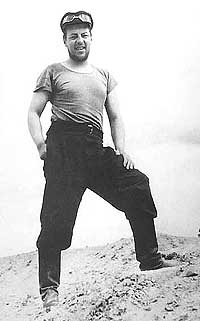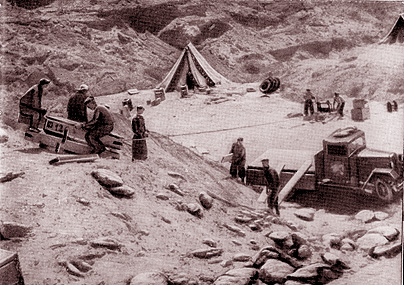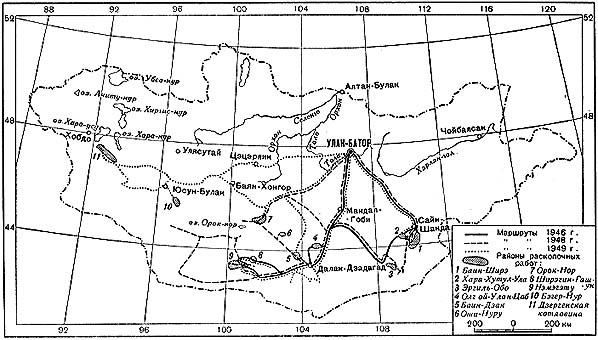Mongolian expedition 1946-1949
Since time immemorial the arats, the native dwellers of Mongolia, have known about many
places with huge stone bones. They believed they were remains of terrible dragons.
The first time Mongolia was discovered as a paleontological Mecca was by the
expedition of the American Museum of Natural History at the early 1920s.
During three seasons of intensive excavations, this expedition, headed by
Roy Chapman Andrews and W.Granger, collected a splendid set of fossils,
including several new forms of dinosaurs.
In 1946 the Mongolian Expedition of the Paleontological Institute started.
It was originally planned for the beginning of the 40-ties, but the World War
destroyed the initial plan. The expedition was headed by Ivan A. Efremov.
 In 1946 the field work lasted for about
two months. The works were mainly aimed at the prospecting of the fossiliferous
localities in the southern and eastern parts of the Gobi Desert. In the autumn
of 1947 the base camps were organized, equipment, provision and gasoline were
delivered. In the spring of 1948 the expedition, that exceeded 30 people headed
for Mongolia.
In 1946 the field work lasted for about
two months. The works were mainly aimed at the prospecting of the fossiliferous
localities in the southern and eastern parts of the Gobi Desert. In the autumn
of 1947 the base camps were organized, equipment, provision and gasoline were
delivered. In the spring of 1948 the expedition, that exceeded 30 people headed
for Mongolia. |
| The half-a-year work included excavations in all the localities
found in 1946. In 1949 the excavations of the already
known and most promising localities containing rich bonebeds of the extinct
animals proceeded. During digging out much attention was paid to
the burial conditions in the particular sites, this served as an important
source of information for the development of a young branch of paleontology -
taphonomy. |
 |
 |
The skeletons of dinosaurs and early mammals were extracted
as huge, up to 2-3 tons, rock blocks and transported to Moscow for fine preparation.
|
 The Russian map of Mongolia showing the routes of 1946-1949 expedition.
The Russian map of Mongolia showing the routes of 1946-1949 expedition.
The expedition tracked about 40,000 km, more than 100
tons of materials were excavated, including the remains of dinosaurs, Cenozoic
mammals and other vertebrates.
During their stay in Mongolia the workers of the expedition helped to organize
the Paleontological Department of the State Museum of the Mongolian People's
Republic.
|

 In 1946 the field work lasted for about
two months. The works were mainly aimed at the prospecting of the fossiliferous
localities in the southern and eastern parts of the Gobi Desert. In the autumn
of 1947 the base camps were organized, equipment, provision and gasoline were
delivered. In the spring of 1948 the expedition, that exceeded 30 people headed
for Mongolia.
In 1946 the field work lasted for about
two months. The works were mainly aimed at the prospecting of the fossiliferous
localities in the southern and eastern parts of the Gobi Desert. In the autumn
of 1947 the base camps were organized, equipment, provision and gasoline were
delivered. In the spring of 1948 the expedition, that exceeded 30 people headed
for Mongolia.
